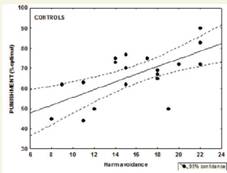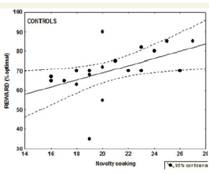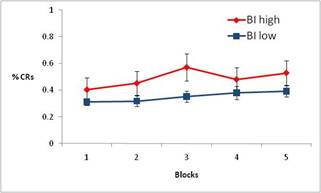Human Learning and Memory
Personality traits that affect learning and memory in healthy individuals
Healthy individuals show a wide variation in learning and memory abilities; some of this variation is associated with different personality traits, such as temperamental tendency for harm avoidance, novelty seeking, or behavioral inhibition. At this point, it’s unknown whether personality traits are innate, and govern learning and memory abilities, or whether the opposite might be true: different individuals (due to genetics and/or brain structure) have different learning and memory abilities, and these help shape our personalities during development and across a lifetime.
SMBI researchers and colleagues have considered a computer-based “game” in which individuals learn through trial-and-error to make responses in order to win points (reward-based learning) and to avoid losing points (punishment-based learning). There is considerable variation on this task in healthy individuals, such that some individuals show much better reward learning than punishment learning, or vice versa. Some of this variation correlates with personality differences such as novelty seeking (a temperamental bias to seek out new stimuli and situations) and harm avoidance (a temperamental bias to avoid risky situations and behaviors). Specifically, among healthy adults, the speed and efficiency of reward learning is correlated with novelty seeking scores, while the speed and efficiency of punishment learning is correlated with harm avoidance scores. High harm avoidance may be related to depression, and so understanding why some individuals are biased to learn more easily from punishment than from reward may provide a clue to understanding risk for depression.

 Left: In healthy adults, performance on a reward-learning test correlates with the personality trait of novelty seeking. Right: Punishment learning correlates with the personality trait of harm avoidance. Adapted from Bódi et al. (2009) Brain, 132, 2385-2395.
Left: In healthy adults, performance on a reward-learning test correlates with the personality trait of novelty seeking. Right: Punishment learning correlates with the personality trait of harm avoidance. Adapted from Bódi et al. (2009) Brain, 132, 2385-2395.
Another important personality trait is behavioral inhibition, a temperamental bias to avoid or withdraw from novel social and non-social situations. We have shown that veterans with high behavioral inhibition faster to learn a simple motor response (defensive eyelid closure in response to a stimulus that predicts an upcoming airpuff to the eye) than veterans with low-to-moderate behavioral inhibition. The same pattern occurs in adolescents and college students. This is potentially important because behavioral inhibition is a risk factor for development of anxiety disorders including post-traumatic stress disorder (PTSD). In fact, development of avoidant behaviors (such as avoidance of reminders of the trauma) is a core symptom of PTSD. It is possible that high behavioral inhibition biases individuals towards facilitated learning of defensive and avoidant behaviors, which in turn increases the risk for development of PTSD when that individual is exposed to highly-stressful events.
 Veterans with high behavioral inhibition (BI; red line) are faster than veterans with low-to-moderate BI (blue line) on acquisition of a defensive motor response: eyelid closure in response to a stimulus that predicts upcoming delivery of an airpuff to the eye. Behavioral inhibition is a vulnerability factor for anxiety disorders including PTSD, possibly because high-BI individuals are biased to learn defensive and avoidant behaviors – a core symptom of PTSD.
Veterans with high behavioral inhibition (BI; red line) are faster than veterans with low-to-moderate BI (blue line) on acquisition of a defensive motor response: eyelid closure in response to a stimulus that predicts upcoming delivery of an airpuff to the eye. Behavioral inhibition is a vulnerability factor for anxiety disorders including PTSD, possibly because high-BI individuals are biased to learn defensive and avoidant behaviors – a core symptom of PTSD.
Understanding the link between behavioral inhibition, facilitated learning, and PTSD could be important in helping us predict which individuals are at highest risk for developing PTSD. Because PTSD only develops in the months following a traumatic event, there is a window of opportunity to intervene with targeted therapy to at-risk individuals – if we could identify who those individuals are. Further, understanding the pre-existing learning biases that make an individual vulnerable to PTSD should help in development of therapeutic strategies that are optimized for particular patients.
Representative Publications:
Myers, C. E., et al. (2010). Faster acquisition of eyeblink conditioning by veterans with symptoms of post-traumatic stress disorder. Proceedings of the Annual Meeting of the Society for Neuroscience, San Diego, CA, Nov. 13-17, 2010.
VanMeenen, K., et al. (2010). "Faster associative learning in behaviorally inhibited adolescents." Manuscript under editorial review.
Bódi, N., et al. (2009). Reward-learning and the novelty-seeking personality: A between- and within-subjects study of the effects of dopamine agonists on young Parkinson’s patients. Brain, 132(Pt 9):2385-2395. Hyperlink to free article: http://www.ncbi.nlm.nih.gov/pmc/articles/PMC2766178/?tool=pubmed
